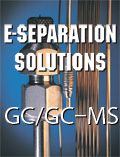The Third Annual LCGC Pittcon Awards: Establishing a Tradition
They say it takes several years for an awards program to really get off the ground and start amassing a history, establishing a place for itself in the industry. If this is true, then I believe we can safely say that this year, the LCGC Pittcon Awards have officially arrived.
They say it takes several years for an awards program to really get off the ground and start amassing a history, establishing a place for itself in the industry. If this is true, then I believe we can safely say that this year, the LCGC Pittcon Awards have officially arrived. With past Lifetime Achievement Award winners such as Walt Jennings and Harold McNair, and bright young stars such as Gert Desmet and Kevin Schug claiming Emerging Leader honors over the past couple of years, there is a great deal of suspense building over who will win the 2010 awards, set to be presented at Pittcon 2010 in Orlando, Florida.
Past winners have gone on to make great contributions to LCGC, writing installments of our well-known “History of Chromatography” column, guest authoring installments of “Column Watch,” and even acting as scientific advisor for the many online projects that are currently in development. In short, this year’s panel of industry experts will have their hands fullmaintaining the tradition of the LCGC Awards, and we have every confidence they will.
The nomination process for the Emerging Leader Award is now open, and in the coming months, the greatly anticipated online reader vote for Lifetime Achievement Award winner will take place, in which the readers of LCGC have a direct say in who this year’s winner will be. To nominate the candidate of your choice, please visit: www.chromatographyonline.com/nominate for the full nomination guidelines. We hope all of our readers will participate in these awards, whether through nominations or by casting a vote. These are truly your awards, so look for more information to arrive in the coming months, including information on how to attend this year’s awards luncheon. We look forward to a successful 2010 LCGC Awards program, and we thank you as always for your continued support.
Determining Neurotransmitters in Spinal Cords with UHPLC
February 18th 2025Researchers at Jilin University (Changchun, China) developed a highly sensitive, rapid, and accurate method for analyzing neurotransmitters (NTs) in rat spinal cord tissue. Ultra-high performance liquid chromatography-triple quadrupole tandem mass spectrometry (UHPLC-QqQ-MS/MS) in conjunction with ultra-ionic liquid dispersive liquid-liquid microextraction (UA-MIL-DLLME) were used to extract NTs for analysis.
The Next Frontier for Mass Spectrometry: Maximizing Ion Utilization
January 20th 2025In this podcast, Daniel DeBord, CTO of MOBILion Systems, describes a new high resolution mass spectrometry approach that promises to increase speed and sensitivity in omics applications. MOBILion recently introduced the PAMAF mode of operation, which stands for parallel accumulation with mobility aligned fragmentation. It substantially increases the fraction of ions used for mass spectrometry analysis by replacing the functionality of the quadrupole with high resolution ion mobility. Listen to learn more about this exciting new development.
Revolutionizing LC-MS with Next-Gen Separation for Cyclic Peptide Analysis
February 17th 2025Cyclic peptides, known for their stability and high specificity, are promising therapeutic agents in the fight against cancer, infections, and autoimmune diseases. However, developing effective cyclic peptides presents numerous challenges, including poor pharmacokinetics, efficacy, and toxicity. Traditional methods like liquid chromatography tandem-mass spectrometry (LC-MS/MS) often struggle with resolving isomeric linear peptide metabolites, posing significant risks in safety, efficacy, and regulatory approval. In this paper, Komal Kedia, PhD, will share how she leveraged MOBIE’s high-resolution ion mobility-mass spectrometry (IM-MS) system to achieve a 72% reduction in run times, 200% greater resolving power, and enhanced accuracy in identifying “soft spots” prone to enzymatic degradation.















